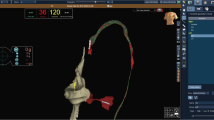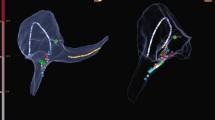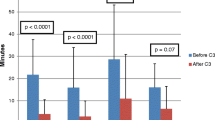Abstract
To evaluate predictors of zero-X ray procedures for supraventricular arrhythmias (SVT) using minimally fluoroscopic approach (MFA). Patients referred for RF catheter ablation of SVT were admitted for a MFA with an electro-anatomical navigation system or a conventional fluoroscopic approach (ConvA). Exclusion criterion was the need to perform a transseptal puncture. 206 patients (98 men, age 53 ± 19 years) underwent an EP study, 93 (45%) with an MFA and 113 (55%) with a ConvA. Fifty-five had no inducible arrhythmias (EPS). Fifty-four had AV nodal reentrant tachycardia (AVNRT), 49 patients had typical atrial flutter (AFL), 37 had AV reciprocating tachycardia (AVRT/WPW), 11 had focal atrial tachycardia (AT), and underwent a RF ablation. X-ray was not used at all in 51/93 (58%) procedures (zero X ray). MFA was associated with a significant reduction in total fluoroscopy time (5.5 ± 10 vs 13 ± 18 min, P = 0.01) and operator radiation dose (0.8 ± 2.5 vs 3 ± 8.2 mSV, P < 0.05). The greatest absolute dose reduction was observed in AVNRT (0.1 ± 0.3 vs 5.1 ± 10 mSV, P = 0.01, 98% relative dose reduction) and in AFL (1.3 ± 3.6 vs 11 ± 16 mSV, P = 0.003, 88% relative dose reduction) groups. Both AVNRT or AFL resulted the only statistically significant predictors of zero x ray at multivariate analysis (OR 4.5, 95% CI 1.5–13 and OR 5, 95% CI 1.7–15, P < 0.001, respectively). Success and complication rate was comparable between groups (P = NS). Using MFA for SVT ablation, radiological exposure is significantly reduced. Type of arrhythmia is the strongest predictor of zero X ray procedure.




Similar content being viewed by others
References
Page RL, Joglar JA, Caldwell MA, Calkins H, Conti JB, Deal BJ et al (2016) 2015 ACC/AHA/HRS guideline for the management of adult patients with supraventricular tachycardia: a report of the American College of Cardiology/American Heart Association Task Force on Clinical Practice Guidelines and the Heart Rhythm Society. J Am Coll Cardiol 67(13):e27–e115
Picano E, Vanõ E (2011) The radiation issue in cardiology: the time for action is now. Cardiovasc Ultrasound 9:35
Vanõ E, Gonzales L, Guibelalde E, Fernandez JM, Ten JI (1998) Radiation exposure to medical staff in interventional and cardiac radiology. Br J Radiol 71:793–808
Linet MS, Kim KP, Miller DL, Kleinerman RA, Simon S, Berrington de Gonzalez A (2010) Historical review of occupational exposures and cancer risks in medical radiation workers. Radiat Res 174:793–808
Committee to Assess Health Risks from Exposure to Low Levels of Ionizing Radiation; Nuclear and Radiation Studies Board, Division on Earth and Life Studies, National Research Council of the National Academies (2006) Health risks from exposure to low levels of ionizing radiation: BEIR VII Phase 2. The National Academies Press, Washington, DC
Smith G, Clark JM (2007) Elimination of fluoroscopy use in a pediatric electrophysiology laboratory utilizing three-dimensional mapping. Pacing Clin Electrophysiol 30:510–518
Miyake CY, Mah DY, Atallah J (2011) Nonfluroscopic imaging systems reduce radiation exposure in children undergoing ablation of supraventricular tachycardia. Heart Rhythm 8:519–525
Mah DY, Miyake CY, Sherwin ED, Walsh A, Anderson MJ, Western K et al (2014) The use of an integrated electroanatomic mapping system and intracardiac echocardiography to reduce radiation exposure in children and young adults undergoing ablation of supraventricular tachycardia. Europace 16:277–281
Casella M, Pelargonio G, Dello Russo A, Riva S, Bartoletti S, Santangeli P et al (2011) “Near-zero” fluoroscopic exposure in supraventricular arrhythmia ablation using the EnSite NavXTM mapping system: personal experience and review of the literature. J Interv Card Electrophysiol 31:109–118
Christoph M, Wunderlich C, Moebius S, Forkmann M, Sitzy J, Salmas J et al (2015) Fluoroscopy integrated 3D mapping significantly reduces radiation exposure during ablation for a wide spectrum of cardiac arrhythmias. Europace 17:928–937
Casella M, Dello Russo A, Pelargonio G, Del Greco M, Piacenti M, Di Cori A et al (2016) Near zerO fluoroscopic exPosure during catheter ablAtion of supRavenTricular arrhYthmias: the NO-PARTY multicentre randomized trial. Europace 18(10):1565–1572
Heidbuchel H, Wittkampf FH, Vano E, Ernst S, Schilling R, Picano E et al (2014) Practical ways to reduce radiation dose for patients and staff during device implantations and electrophysiological procedures. Europace 16(7):946–964
Estner HL, Bongiorni MG, Chen J, Dagres N, Hernandez-Madrid A, Blomström-Lundqvist C (2015) Use of fluoroscopy in clinical electrophysiology in Europe: results of the European Heart Rhythm Association Survey. Europace 17:1149–1152
Picano E, Vanõ E, Rehani MM, Cuocolo A, Mont L, Bodi V et al (2014) The appropriate and justified use of medical radiation in cardiovascular imaging: a position document of the ESC Associations of Cardiovascular Imaging, Percutaneous Cardiovascular Interventions and Electrophysiology. Eur Heart J 35:665–672
Fazel R, Gerber T, Balter S, Brenner DJ, Carr JJ, Cerqueira MD et al, On behalf of the American Heart Association Council on Quality of Care and Outcomes Research, Council on Clinical Cardiology, and Council on Cardiovascular Radiology and Intervention (2014) Approaches to enhancing radiation safety in cardiovascular imaging. A scientific statement from the American Heart Association. Circulation 130:1730–1748
Kottkamp H, Hugl B, Krauss B, Wetzel U, Fleck A, Schuler G, Hindricks G (2000) Electromagnetic versus fluoroscopic mapping of the inferior isthmus forablation of typical atrial flutter: a prospective randomized study. Circulation 102:2082–2086
Willems S, Weiss C, Ventura R, Ruppel R, Risius T, Hoffmann M, Meinertz T (2000) Catheter ablation of atrial flutter guided by electroanatomic mapping (CARTO): a randomized comparison to the conventional approach. J Cardiovasc Electrophysiol 11:1223–1230
Sporton SC, Earley MJ, Nathan AW, Schilling RJ (2004) Electroanatomic versus fluoroscopic mapping for catheter ablation procedures: a prospective randomized study. J Cardiovasc Electrophysiol 15:310–315
Ventura R, Rostock T, Klemm HU, Lutomsky B, Demir C, Weiss C et al (2004) Catheter ablation of common-type atrial flutter guided by three-dimensional right atrial geometry reconstruction and catheter tracking using cutaneous patches: a randomized prospective study. J Cardiovasc Electrophysiol 15:1157–1161
Earley MJ, Showkathali R, Alzetani M, Kistler PM, Gupta D, Abrams DJ et al (2006) Radiofrequency ablation of arrhythmias guided by non-fluoroscopic catheter location: a prospective randomized trial. Eur Heart J 27:1223–1229
Muto C, Canciello M, Carreras G, Ottaviano L, Ascione L, Angelini S, Tuccillo B (2007) Is it possible to create a linear lesion with no local electrograms? Comparison between a three-dimensional mapping system and conventional fluoroscopy for cavotricuspid isthmus ablation of typical atrial flutter. J Cardiovasc Med 8:414–418
Hindricks G, Willems S, Kautzner J, De Chillou C, Wiedemann M, Schepel S et al (2009) Effect of electroanatomically guided versus conventional catheter ablation of typical atrial flutter on the fluoroscopy time and resource use: a prospective randomized multicenter study. J Cardiovasc Electro physiol 20:734–740
Kopelman HA, Prater SP, Tondato F, Chronos NAF, Peters NS (2003) Slow pathway catheter ablation of atrioventricular nodal re-entrant tachycardia guided by electroanatomical mapping: a randomized comparison to the conventional approach. Europace 5:171–174
Spector P, Reynolds MR, Calkins H, Sondhi M, Xu Y, Martin A et al (2009) Meta-analysis of ablation of atrial flutter and supraventricular tachycardia. Am J Cardiol 104(5):671–677
Giaccardi M, Del Rosso A, Guarnaccia V, Ballo P, Mascia G, Chiodi L et al (2016) Near-zero X-ray in arrhythmia ablation using a 3-dimensional electroanatomic mapping system: a multicenter experience. Heart Rhythm 13(1):150–156
Giaccardi M, Mascia G, Paoletti Perini A, Giomi A, Cartei S, Milli M (2018) Long-term outcomes after “zero X-ray” arrhythmia ablation. J Interv Card Electrophysiol 54(1):43–48
Pani A, Giuseppina B, Bonanno C, Bongiorni MG, Bottoni N, Brambilla R et al (2018) Predictors of zero X-ray ablation for supraventricular tachycardias in a nationwide multicenter experience. Circ Arrhythm Electrophysiol 11(3):e005592
Shurrab M, Laish-Farkash A, Lashevsky I, Morriello F, Singh SM, Schilling RJ et al (2013) Three-dimensional localization versus fluoroscopically only guided ablations: a meta-analysis. Scand Cardiovasc J 47(4):200–209
Author information
Authors and Affiliations
Corresponding author
Ethics declarations
Conflict of interest
The authors declare that they have no conflict of interest.
Ethical approval
The study was approved by the ethics committee and have therefore been performed in accordance with the ethical standards laid down in the 1964 Declaration of Helsinki and its later amendments.
Informed consent
All persons gave their informed consent prior to their inclusion in the study.
Research involving human and animal rights
The research involved human participants.
Additional information
Publisher's Note
Springer Nature remains neutral with regard to jurisdictional claims in published maps and institutional affiliations.
Rights and permissions
About this article
Cite this article
Di Cori, A., Zucchelli, G., Segreti, L. et al. Predictors of zero X ray procedures in supraventricular arrhythmias ablation. Int J Cardiovasc Imaging 36, 1599–1607 (2020). https://doi.org/10.1007/s10554-020-01884-8
Received:
Accepted:
Published:
Issue Date:
DOI: https://doi.org/10.1007/s10554-020-01884-8




